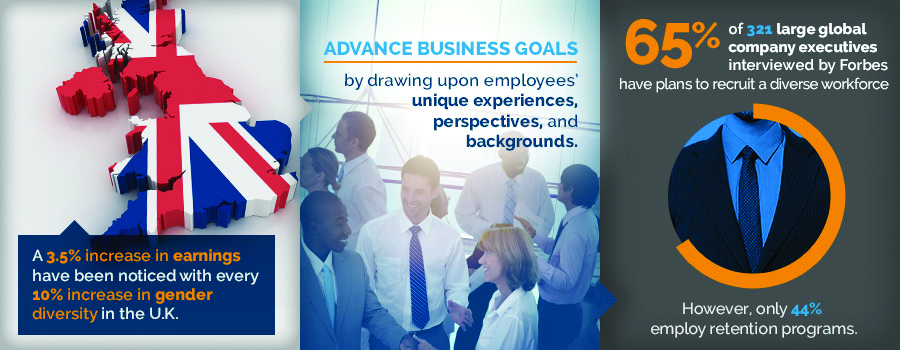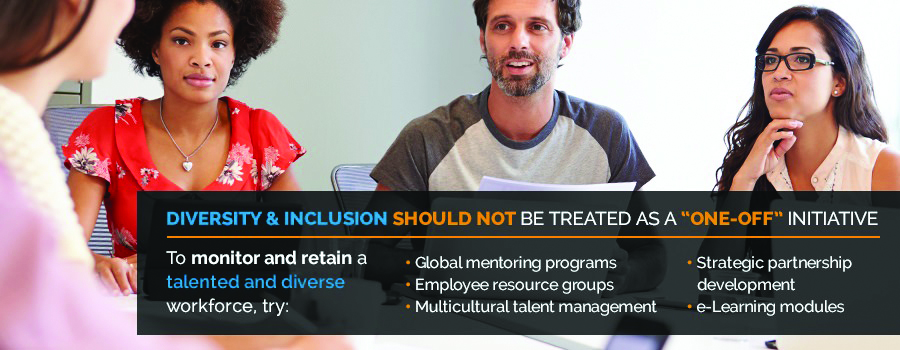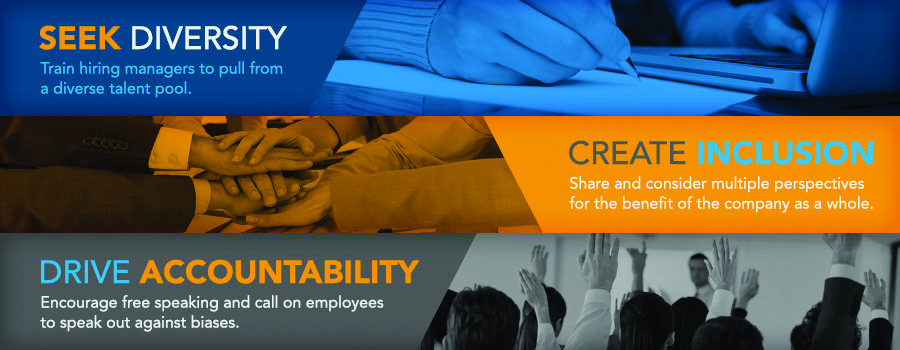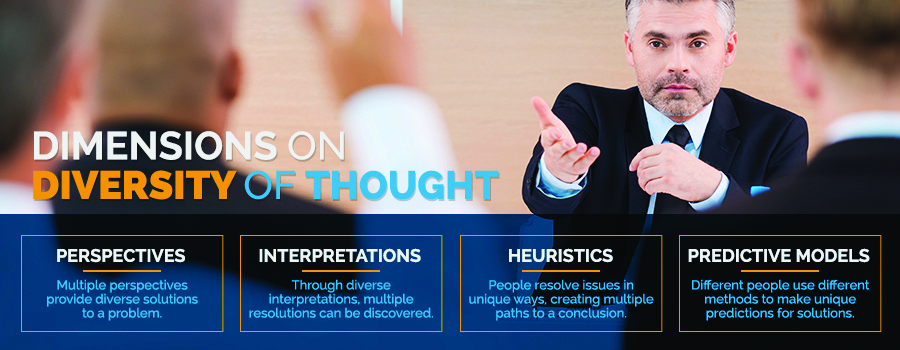
Article provided by aperianglobal.com
David is in charge of workplace diversity management at a global manufacturing company. He was recently assigned a seemingly basic task. “Focus on minorities,” the executive sponsor of the initiative told him. “I’d like to see our numbers climb from 25 to 45 percent,” he said.
Minorities are largely underrepresented at the company, but David knew that was only a small part of a larger problem. Women are also grossly underrepresented, especially among senior employees. Additionally, there are no current initiatives to hire people with disabilities, nor is there a policy in place that promotes diverse ways of thinking.
Frustrated at the narrowed focus of his duty, David immediately felt discouraged. Through his experiences, he has learned that to achieve greater diversity and inclusion (D&I), organizational efforts will need to focus beyond just the numbers. To effect positive and measurable change within an organization, David knows it is imperative to focus efforts on a collective and multidimensional solution.
Later that day, David chatted with a team of his coworkers in different countries during a conference call. Some of them echoed something he has heard plenty of times in the past. Jason, a colleague in Singapore, stated, “Simply focusing on hiring minorities isn’t enough. The offices here, for example, employ a huge number of minorities, but they aren’t included as key decision makers, and they’re rarely promoted to executive positions.”
David and Jason both agree that their company should continue to hire more people from underrepresented groups, but that a single focus will not do much to solve any of the larger problems. They understand that companies with gender, ethnic and racial diversity are at least 15 percent more likely to experience above-average financial returns. They also know that companies within the top quartile for racial and ethnic diversity are 35 percent more likely to do the same.
These statistics imply a significant relationship between competitive profit gains and diversity, so why, exactly, is focusing on minorities not enough for a global company?
Why are members of the global workforce — such as David and Jason — frustrated with one-way initiatives that do nothing more than single out certain groups of people?
And most importantly: what can we learn from top companies successfully globalizing workplace diversity and inclusion?
Managing diversity and inclusion in the global workplace is, in many ways, an unmapped territory. As such, we share five lessons from the following top global companies:
- Earning a spot on DiversityInc’s Top 50 in 2015, 2014 and 2013, BASF is a global force properly leveraging D&I.
- Ford Motor Company. Ford made DiversityInc’s Top 50 an impressive 11 times.
- Sodexo. Sodexo was the recipient of the Catalyst Award in 2012 and earned a spot on DiversityInc’s Top 50 on eight different occasions.
- AIG. In 2015, AIG earned a spot on DiversityInc’s 25 Noteworthy Companies list for the second year in a row. The company’s talent pipeline, equitable talent development, CEO and senior leadership commitment and supplier diversity were assessed.
- L’Oréal. In 2006, the World Diversity Leadership Council presented L’Oréal USA with the Corporate Diversity Innovation Award, as well as the DANDI Award in 2012.
- Deutsche Bank. Named as one of the Top 50 Employers for Women, Deutsche Bank also won an award for its global sponsorship program ATLAS, which helps women progress to senior positions.
- Bayer. Known for years for its effective eLearning modules and other non-traditional strategies for D&I, Bayer was named a Top 10 Company for Asian Americans, as well as a Top Global Company by DiversityInc.
- Johnson & Johnson. The global healthcare company was listed on DiversityInc’s Top 50 eleven times.
These leading organizations are paving the way for the future of diversity and inclusion. Between fostering innovation and learning to properly monitor — and model — their efforts, we have gleaned from these leading global companies five important lessons for organizations to successfully implement diversity and inclusion efforts that will have global relevance.
Lesson 1: Recognize the Shift in Global Understanding of D&I
As David and Jason realize in the above scenario, diversity today means more than race and gender. There’s growing significance placed on creating environments where a variety of different voices are encouraged and heard. These voices come from people who may or may not be of the same gender, race, or ethnicity. Diversity in the workplace today can include some of the following:
- Race
- Ethnicity
- Gender
- Sexual orientation
- Religious affiliation
- Generation
- Disability
- Personality type
- Thinking style

This new way of thinking about D&I focuses on meeting the needs of the individual and not so much on an HR-centered initiative. Today, it is not only about having diversity within a company but leveraging that diversity to produce better products and services.
It is crucial to hire and maintain a diverse workforce, so gender and racial/ethnic initiatives will be launched and maintained into the foreseeable future. There is much to learn from leaders in diversity and inclusion, but it is important to remember that every company’s D&I initiatives will look different. You should tailor your initiatives to address your specific industry and your company’s areas of weakness. Furthermore, global strategies should be able to be adopted locally.
It is wise to remember that diversity means different things to different people, and organizations will apply those definitions to their companies respectively. For example, the percentage of workers of European ancestry in the UK decreased by almost 10 percentage points over the last ten years. This presents an area of focus unique to the UK workforce.
Another example is the focus on people with disabilities in India, where many people suffer from polio or other diseases because medicine was not available to treat them. Because of this, Deutsche Bank works with a non-governmental organization to train people with disabilities to work at the company.
It’s clear that the shift in D&I still includes, but stretches beyond, race and gender. We are in need of a collective push toward recognizing the need for diverse thinkers coming from a variety of different backgrounds, but companies are only slowly moving in this direction.
Take the story of Todd Sears as an example. He began his career as a Wall Street investment banker in an environment that was not accepting of homosexuality. He eventually found a position in a more welcoming environment, where he flourished and eventually went on to pursue his own firm in a new market: private banking focusing on LGBT clients.
Sears’ statement is a testament to the changing forecast of D&I: “For me, it’s business first, and business as a vehicle to achieve social justice and civil rights.”
His statement provokes further thoughts about for-profit organizations and their dedication to advancing society on a global level. We all know intuitively that D&I initiatives are morally right, but realistically speaking, businesses are going to do what is best for the bottom line. This fact rouses sentiments about social responsibility, and part of this view naturally considers supplier diversity.
Few companies are as successful as Ford when it comes to supplier diversity. In November of 2014, The National Minority Supplier Development Council named Carla Preston of Ford Motor Company a Minority Supplier Development Leader. In 2013, Preston’s efforts led to Ford adding 16 new Tier 1 diverse suppliers to its network, accounting for $4.8 million in spend. That year, Ford granted $1.08 billion of new business to diverse suppliers.
This example proves that a global entity can indeed leverage diversity in many ways and see extremely positive results. This is proof that what is morally right can also be the best business decision.
There are aspects of running a global business that are the same across the board, such as making a profit and putting forth efforts into D&I. There are also unique concerns that come with operating through different cultures and regions.
Lesson 2: Build an Inclusive Environment

Studies show that diversity and inclusion efforts are worthwhile, especially on a global level. In the United Kingdom, senior executive teams proved a 3.5 percent increase in earnings before interest and taxes with every 10 percent increase in gender diversity.
This implies that global business leaders should strive to create an atmosphere where multiple voices are heard, and their opinions are valued and considered. This fact should be engrained in the company culture. In the example scenario, David and Jason realized the importance of an inclusive global workplace, but were frustrated with the focus on a single group of workers – and frustrated that the company culture lacked a focus on global talent.
Few senior executives have realized the importance of a diverse workforce powered with voices of people from different backgrounds, personalities and thinking styles across the global workplace. It has become important to create environments where all people are encouraged to draw upon their unique experiences, perspectives and backgrounds to advance business goals. To achieve this in a global work setting, it’s crucial to employ effective global communication and training efforts.
Healthcare provider Johnson & Johnson, for example, realized that to be successful in global diversity, it needed culturally appropriate efforts launched for every region. The company was struggling to combine its diversity efforts in the United States and Europe, so it conducted its first-ever live video conference on mutual perceptions, diversity and respect. Clients and employees reported increased productivity, and over 100 survey participants reported the conference was the most valuable training they had ever experienced.
Another example of a global company realizing the depth and scope of inclusive environments is Deutsche Bank, a signatory and founding member of diversity charters in Germany, Spain and Luxembourg. About 42 percent of its employees are female. Eileen Taylor of Deutsche explained, “We are in 75 countries and we hire the best talent in each locale. Diverse teams and companies make better decisions.”
Considering these examples, it’s clear that some of the top organizations around the world have set an example for diverse and inclusive global work environments. As these organizations continue their efforts and others follow, how do they continuously improve? And, more importantly, what areas of D&I are companies still falling short?
Sixty-five percent of 321 executives of large global companies surveyed by Forbes Insights claimed to have a plan in place to recruit a diverse workforce — but only 44 percent employ retention programs. This signifies a gap in collective progress when it comes to retaining diversity and inclusion in the workplace. In other words, you cannot simply have diversity; you must learn to leverage and nurture it so that it can thrive.
Lesson 3: Use Multiple Practices and Measures

Diversity and inclusion should not be treated as a ‘one-off’ initiative. Many leaders struggle with how to manage workplace diversity. Promoting diversity and inclusion in the workplace is a constant work in progress, and it should be maintained and nurtured to be effective.
According to a 2014 HUDSON Research & Consulting study that interviewed six D&I leaders from leading non-U.S.-based companies, there is a need for multiple initiatives and many sources of feedback.
Instead of looking at turnover rates and other numbers, there is a need for measuring ROI based on different indicators and granular information, such as employee responses and consistent feedback about policies.
Chemistry giant BASF employs a talent dashboard that allows leaders to gauge D&I progress by asking comprehensive questions about their thoughts on the hiring process and retention trends. This ensures that multiple voices are heard and encourages employees to voice their opinions. Strategies like this give a voice to employees who might not otherwise express their opinions.
Another example of a successful global company utilizing multiple practices and measures is the German chemical and pharmaceutical company Bayer. It uses eLearning modules as a way of providing ongoing education to employees. This type of resource provides employees with consistent reminders of the company’s values and expectations.
David and Jason at the global manufacturing company would likely appreciate such efforts. A talent dashboard would allow them to voice their concerns in a safe atmosphere, as well as show them that leadership cares about their concerns. The eLearning modules would serve as a way to educate employees across the globe, placing emphasis on things that matter beyond racial and gender diversity.
The takeaway is that your global company should have solutions in place to monitor and retain a talented and diverse workforce, such as any of the following:
- Global mentoring programs
- Employee resource groups
- Multicultural talent management
- Strategic partnership development
- e-Learning modules
Lesson 4: Ensure Leaders Model Diversity and Inclusion

It is critical that senior leadership model diversity and inclusion. When senior leaders own D&I and make themselves a part of the diversity and inclusion management process, it sets the tone for the rest of the organization to follow suit. “I have to be the champion of diversity and inclusion,” said L’Oréal USA CEO Frédéric Rozé. “It is my job to be a role model and show how important this is to our company.”
BASF is an excellent example of a global company that introduces D&I training programs to senior executives to promote diversity throughout the organization. BASF’s Ambassador Network includes over 500 employees worldwideand encourages the creation of an “open corporate culture that values every individual.”
Is there a secret formula to learning how to manage workplace diversity, especially considering the breadth of differences between global companies? Here are three steps imperative to obtaining inclusive leadership.
- 1. Seek diversity
Companies must pull applicants from a diverse pool using the best techniques. Most global companies understand this fact, but it is not enough. Best practices include training hiring managers to ensure the hiring criteria and process is inclusive.
- 2. Create inclusion
It is not enough to only hire a diverse workforce. It is crucial to leverage diverse perspectives for the benefit of the business as a whole. It is important to bring awareness to unconscious bias and discuss it in terms of the organization. In doing so, multiple perspectives are shared and considered.
- 3. Drive accountability
Leaders in diversity and inclusion should make it clear that your global environment promotes free speaking. Encourage employees to speak out against biases. If necessary, launch a culture change in which every employee is involved.
This process can be slow and intimidating, but your efforts will pay off when employees feel empowered to take individual accountability and let you know when they notice a bias. Diversity and inclusion activities in the workplace are not always a simple process. In fact, sometimes they can be quite messy. But it is often in these situations — in which employees step outside of their comfort zones and are faced with new situations and ideas — that tremendous growth occurs.
A global organization catching on to this need for inclusive leadership is Ford Motor Company, which recognizes the need for leveraging different skills and perspectives, and for “respecting each other, and, in doing so, achieving profitable growth for all.”
Kiersten Robinson, Vice President of Human Resources, Asia Pacific and Africa at Ford, was born in Ireland and immigrated to Australia as a child. She experienced cultural differences and was always well aware of her own as an immigrant. She learned at a young age the positive outcomes born from leveraging diversity and integrated that knowledge into her career. Robinson believes that organizations should use varying insights and perspectives as opportunities to increase customer satisfaction.
Lesson 5: Recognize the Connection Between Innovation and D&I
Perhaps the most significant lesson is that diversity and inclusion spark innovation. In AIG’s 2014 corporate citizen report, for example, it included leveraging cognitive diversity to drive innovation as a D&I principle. According to the global enterprise, diversity and inclusion increase innovation and reduce business risk.
The enterprise focused its efforts on three areas in 2014:
- Nomination programs. It hosted training for 350 employees in nine countries representing the enterprise’s every region. The efforts focused on women and under-represented groups.
- Training programs. A global initiative was launched in over 20 countries to address general diversity and also train managers in cultural competence, generation diversity and unconscious bias.
- Employee resource groups. The enterprise’s employee resource groups experienced a growth rate of 76 percent in one year. It expanded to 10 different dimensions of diversity, added to 36 existing chapters and launched 37 new groups.
This new trend among top global companies fostering innovation in the workplace encourages other global businesses to do the same.

If you want to begin exploring the concept of cognitive diversity in the workplace, know that it focuses on diversity of thinking and is composed of four dimensions:
- Perspectives. People represent situations in different ways. In the global workplace, it will help to have multiple perspectives when it comes to representing a problem, as they will see different possible solutions.
- Interpretations. Employees interpret situations, problems and other people in different ways, classifying them accordingly. Through diverse interpretations, teams can discover multiple resolutions.
- Heuristics. People resolve issues in different ways, proving there are multiple ways to arrive at a conclusion.
- Predictive models. To make predictions, some people analyze, and others look for a story. Both are useful to discovering workplace solutions.
Cognitive diversity breeds high performance while completing complex tasks. Global workforces powered with diverse thinkers hold the ability to foster innovation. It is important to note that there are two possible roadblocks to this innovation:
- Unconscious bias
- A corporate culture that doesn’t promote sharing any and all opinions
Unconscious bias is difficult to overcome, but there are steps you can take to overcome it in the global workplace:
- Realize your tendencies and natural reactions to people different from you in some way.
- Expand your support network and go to different people for advice.
- Invite more people to make important decisions.
World leader in quality-of-life services Sodexo is well known for its forward thinking and ability to recognize all work together to identify bias. The company was recognized with one of Canada’s Best Diversity Employers awards for two years in a row. President of Sodexo Canada Barry Telford explained, “Diversity is not just about each group getting their moment. We must and make a commitment at all levels of the organization not to overlook our most talented and resilient team members.”
Leaders in diversity and inclusion should reward employees who are not afraid to voice an unpopular opinion or suggest something different than what’s expected. Dr. Rohini Anand of Sodexo USA said, “Inclusive leadership starts with self-awareness, being introspective, knowing your blind spots and possessing the ability to listen and learn.”
The ability to listen and learn can only be valuable if employees are encouraged to speak their minds, even when they are expressing an unpopular opinion or suggesting a new idea. Smart, successful global teams understand that differing opinions spark innovation — and that it is a crucial part of high performance. Without recognizing bias and considering different viewpoints, growth will likely be slow moving.
David and Jason’s global manufacturing company would likely benefit from an amended corporate culture that promotes diverse thinkers and promotes recognizing unconscious bias. They would likely experience fewer workplace frustrations as employees are encouraged to voice their opinions and multiple solutions are considered.
With so many considerations, it can be difficult to know where to start or where to focus your efforts. Learning to leverage global workplace diversity is far from simple, and learning to manage, maintain and measure your efforts will take time. Leaders in diversity and inclusion have taught us that it is an ongoing process, and it might require the help of an outside source — one that specializes in global diversity and inclusion in the workplace.
Putting Diversity & Inclusion Into Practice
Are you ready to take concrete steps and develop your company’s D&I policy and practices?
Learn how to create an inclusive workplace.
Article from aperianglobal.com
